|
Inside
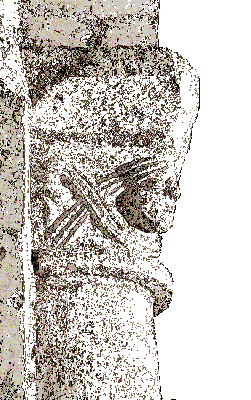 |
Capitels
: Their style
is classic Romanesque: over a torus base, a carved echinus topped
by chamfered abacus..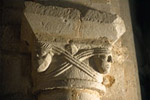 Despite their
simplicity
they display elaborated combinations from three main elements: human
heads, leaves (plain or palms), interlaces (plain, ribbon, dotted). Despite their
simplicity
they display elaborated combinations from three main elements: human
heads, leaves (plain or palms), interlaces (plain, ribbon, dotted).
Given
the very strong unity of construction, we may assume that, like the
choice of elements, the distribution of their combinations could
suggest a Christian symbolism older than the representation of Biblical
subjects
For more details
on early experiments to represent human figures on an interlaced
background, links the site of Conques.
|
|
Piscina :
In spite of his etymology it is not an
olympic swimming pool, not even a baptistery large enough to permit
imersion,
as in Poitiers the Baptistère Saintt Jean. It is in fact a small sink
(the conical part is about 20 cm in diameter) 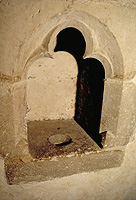 where
the priest emptied the water used for rinsing the sacred vessels. The
water
pours off and is absobed in the inner
fondations. where
the priest emptied the water used for rinsing the sacred vessels. The
water
pours off and is absobed in the inner
fondations.
This practice disappeared
numerous centuries
ago and piscinae were often transformed, or walled up, or buried by
raising of floor level. The trefoil arch, more recent, proved the
custom to be continued later in Brux than somewhere else.
The paintings
Virgin and
Child :
XVII C, attributed to the school of Van Dyck. Perhaps presented
late XVIII C by one of the Montalembert, lords of Epanvilliers.
Recently beautifully restored along with another work showing Joseph’s Dream,
copied from an original by Simon Vouet, a French contemporary of Van
Dyck, these paintings hang facing one another high up in the choir. More on this pages
The
funeral litre : A funeral litre (or "listre", same etymology
as
"list") is a black strip the lords had right to paint,
decorated
with their coat of arms, in the churches in honour of their dead. It
runs on the aisles walls. The layer of lime whitewashing was removed
and the listre fully restored in 1993-94. A naked Mélusine decorate
some of the 12 shields of the Saint-Georges de Vérac family, lords of
Couhé and Brux.
|
|
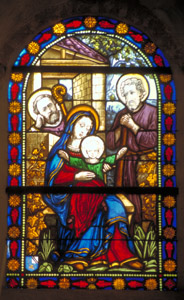
|
The stained-glass window
The Holy Family
and Saintt Martin by Guéribault, 1870. Size: 1m x 0,6m.
This well made window was
commissioned by the
family Rivaud de la Raffinière. On the right, St Martin face, set
upright and without halo probably shows the portrait of the patron.
Restored in 1993-94 by Ateliers Louis
Martin |
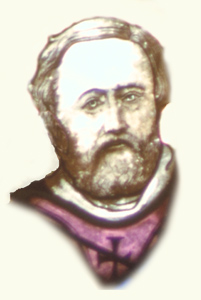
|
Altars
: A modern style altar in the form of a freestanding table
was
inaugurated after the completion of the restoration of the church
interior and dedicated in 2003. It stands in front of the XIX C
altarpiece with built-in tabernacle, on the front of which is a
decorative panel showing Saint Martin asserting his readiness to serve
as
a soldier of Christ. The niche to one side, containing the ‘veilleuse’
light kept lit to mark the presence of the Host in the tabernacle, is
backed by a square slab of slate marked with crosses; this is in fact
an altar of XVII C date, which would originally have been mounted in a
wooden table, and which would have accompanied an individual priest
from Parish to Parish.
***
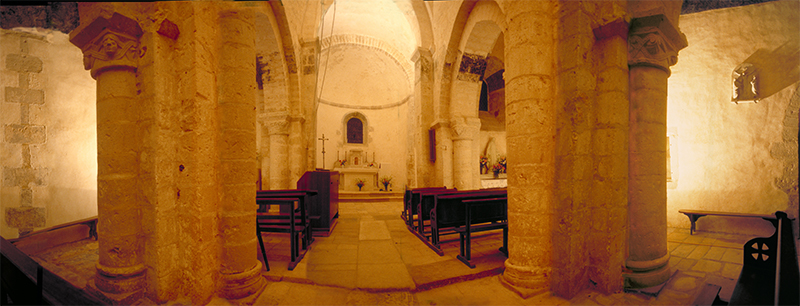

Fish-eye panoramics - 1997
|
![]()